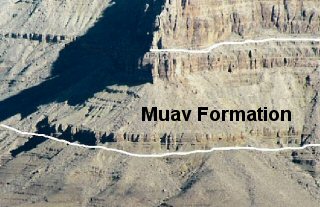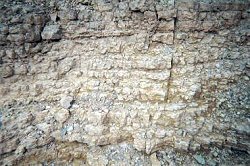*********************************************
Muav Formation
Cambrian Period, 505 Million Years Old, 375 Feet Thick
Ledges and slopes below the Redwall cliff

The Muav is a mottled, nodular, shaly, yellowish-gray limestone. In the eastern Canyon it is a yellowish cliff in the lower part, a covered slope in the middle, and a ledgy cliff, often stained red, in the upper part where it contacts the Redwall (or Temple Butte Formation). Muav fossils include trilobites and brachiopods as well as scattered invertebrate tracks and trails. Of the Tonto formations, the Muav was deposited farthest from shore.

Right: a close view of the lumpy, nodular Muav Limestone. In eastern Grand Canyon, the part toured by most visitors, the Muav is a relatively near shore shaly formation containing much terriginous material. Further west it is a more pure marine limestone.